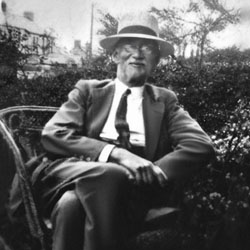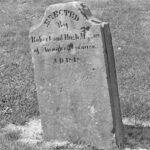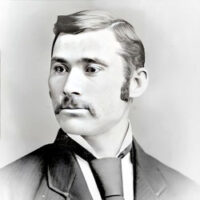In the bustling city of Belfast, Ireland, where the mighty ships of Harland & Wolff were born, a man named James Megraw Jr. carved out a remarkable life, leaving an indelible mark on his community through his deep dedication to Freemasonry, his faith, and his steadfast principles.
Hailing from the picturesque townland of Magherascouse, County Down, James’ journey began on June 24th, 1860 – the feast day of St. John the Baptist, one of the patron saints of Freemasonry whose annual celebration was deeply significant to the fraternal order that had long defined his family.
Freemasonry and the Megraw Legacy
Freemasonry has deep roots in Ireland, dating back to the early 18th century. The Grand Lodge of Ireland, established in 1725, is the second oldest Grand Lodge in the world. Throughout the 18th and 19th centuries, hundreds of Masonic lodges were founded across the country, serving as hubs for social, intellectual, and philanthropic activities. James Megraw Jr.’s own family had long been involved in Irish Freemasonry, with his ancestors Ansley Megraw (ca.1775-1820) from 1793 to 1796 and John Megraw ( – ) in the early 1800s affiliated with the ancient Saintfield Union Lodge No. 425.
James’ father, James Megraw Sr., was the Worshipful Master of Ballygowan Lodge No. 136 in Magherascouse. He took great pride in carrying his newborn son James Jr. into a lodge meeting, presenting the newest addition to the fraternity. This legacy of Masonic involvement would become a defining thread in James Jr.’s life.
Following in his father’s footsteps, James Jr. joined the Abercorn Lodge No. 114 in Ballymacarrett on July 1st, 1891. Rising through the ranks, he became a Past King of the Craigantlet Royal Arch Chapter in Holywood, serving as its secretary from 1918 to 1931. Throughout his life, James Megraw Jr. remained deeply involved in the Masonic Order, becoming the secretary of the Ballymacarrett Lodge No. 436, a position he held for over a decade.
In 1924, James Megraw Jr. assisted William George Simpson in researching the history of the former Ballygowan Lodge No. 136, which had met in the attic of the Bowman family’s cottage in Magherascouse for over 30 years until its warrant was called in 1887. The two men’s visit to the century-old cottage provided a glimpse into the rich Masonic heritage of the region, which Simpson later captured in his book “Masonry of the Olden Time in the Comber District, County Down, Ireland” (1926).
Building a Career in Shipbuilding
James’ professional journey mirrored the industrial growth of Belfast in the late 19th and early 20th centuries. He began his career working at the renowned Workman, Clark & Co. shipyard, one of the largest and most successful shipbuilding firms in Belfast. The company built a wide range of vessels, from cargo ships to passenger liners, and played a key role in transforming Belfast into a global hub of shipbuilding.
After gaining experience at Workman, Clark & Co., James’s skills earned him a promotion to yard manager, a position he held for several years before moving to Cammell Laird & Co. in Birkenhead, England. Cammell Laird was another prominent shipbuilding company, known for constructing advanced and famous vessels, including the renowned HMS Ark Royal, the first British warship to be designed and built as an aircraft carrier.
James later returned to Belfast, resuming his role at Workman, Clark & Co. before joining the prestigious Harland & Wolff shipyard. Harland & Wolff was the largest and most prominent shipbuilder in Belfast, responsible for constructing iconic ships like the ill-fated RMS Titanic. According to family accounts, James may have been involved in the planning of the Titanic, as it is said that he, along with his colleagues, helped to chalk out the plans for the vessel on the tiled floor of the scullery in his home. Though the extent of James’s direct involvement is unclear, this anecdote does suggest he was associated with the Titanic project, underscoring the significance of Harland & Wolff’s shipbuilding legacy during his tenure at the company.
Marriage and Family
In October 1882, James Megraw Jr. married Emily McCreary Lowry, daughter of Thomas and Elizabeth Murdock, in Belfast. Together, they raised a large family, welcoming eight children into the world:
i. Frederick James Megraw (b. 1883)
ii. Emmeline Beatrice Megraw (b. 1884)
iii. Helena Gertrude Allen Megraw (b. 1886)
iv. Harold Thomas Lowry Megraw (b. 1888)
v. Wilfred Ansley Megraw (b. 1890)
vi. Edith Irene Maude Megraw (b. 1892)
vii. Bertram Stanley Rutherford Megraw (b. 1894)
viii. Ida Ethelwynne Octavia Megraw (b. 1901)
James’ own childhood had been marked by immense tragedy. Shortly before Christmas in 1870, when he was just 10 years old, his father James Megraw Sr., a blacksmith by profession, passed away at the young age of 45 from “heart disease.” James’ mother, Jane, was now a widow and suddenly responsible for raising her four young sons alone, the youngest just 4 years old.
Two years later, the family’s grief was compounded when James’ eldest brother, Robert John, an apprentice painter, tragically died after falling off a ladder. This left the widowed Jane with three remaining young sons, the eldest of whom was only 12 years old. Despite the incredible hardship, James’ mother displayed remarkable determination and resilience, finding a way to provide for her sons until they were old enough to start earning their own wages and support the family. Through these formative years, young James undoubtedly learned valuable lessons about perseverance and the importance of family that would shape the rest of his life.
In 1929, further tragedy struck the family when James Jr.’s son Harold lost his wife at the young age of 33 in England, where they were raising a family of three daughters and a son. Faced with the responsibility of caring for four young children, James Jr. and his wife Emily, now almost 70 years old, decided to keep the family together by having the children move in with them at their home in Bangor, County Down. Their youngest daughter, 28-year-old Ida Megraw, who was unmarried and living in Belfast at the time, gave up her job to help her parents care for the grandchildren. This selfless act speaks to James Megraw Jr.’s strong family values and his willingness to put the needs of his loved ones first, even in his later years.
A Man of Faith and Temperance
Beyond his professional accomplishments, James Megraw Jr. was a man of deep faith and unwavering principles. He was a devoted member of the Bloomfield Presbyterian Church for 37 years, serving as the first elder and superintendent of the Sabbath School. His commitment to the church was so steadfast that he only missed one service in all those years.
James’ dedication to his faith was matched by his ardent belief in the temperance movement, which gained significant traction in Belfast during his lifetime. As a founding member of the Belvoir Rechabite Tent, an organization dedicated to promoting abstinence from alcohol, James played a significant role in advancing the principles of temperance in his community.
The temperance movement advocated for sobriety, viewing alcohol as a scourge on society and a cause of numerous social problems. By advocating for abstinence and setting an example through his own lifestyle, James contributed to broader social reform efforts aimed at improving the lives of Belfast’s residents, many of whom were employed in industries like shipbuilding where alcohol consumption was seen as undermining worker productivity and contributing to the cycle of poverty.
The Passing of a Patriarch and a Lasting Imprint on History
On a somber August afternoon in 1934, the community of Bangor, County Down gathered to bid a final farewell to James Megraw Jr., a man whose life had been a testament to unwavering faith, steadfast principles, and unwavering dedication to his family and community. At the age of 74, Mr. Megraw had passed away at his beloved residence, “Bemersyde,” after a period of failing health.
The funeral procession made its way from Bemersyde to Comber Churchyard, where the Pastor of the Bloomfield Presbyterian Church, the congregation James had faithfully served for over three decades, conducted the solemn services. The pallbearers, Mr. Megraw’s three sons – Wilfred, Harold, and Stanley – solemnly carried their father’s casket, a heavy burden that surely weighed upon their hearts as they bid a final farewell to the man who had guided and supported them throughout their lives.
The large and diverse gathering that had assembled to pay their respects was a testament to the high esteem in which James Megraw Jr. had been held within the community. From his Masonic brethren to the members of his church, all had come to bid farewell to a man whose life had been a shining example of integrity, service, and devotion.
That James Megraw Jr. had been able to overcome the adversity-filled beginnings of his life to carve out such an accomplished and impactful legacy spoke volumes about his unwavering determination and the values instilled in him from a young age. Though his name may not be carried by all of his descendants, the spirit of James Megraw Jr. would live on, inspiring future generations to emulate the principles that had defined his remarkable life.




